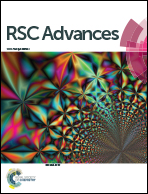Magnetic nano-sized cadmium ferrite as an efficient catalyst for the degradation of Congo red in the presence of microwave irradiation
Abstract
A highly active nano-sized CdFe2O4 catalyst was prepared by a hydrothermal process and characterized by X-ray diffraction (XRD), scanning electronic microscopy (SEM), BET specific surface area method, and vibrating sample magnetometer (VSM) at room temperature. Application of the microwave-induced catalytic degradation method in the abatement of Congo red (CR) using the magnetic catalyst was studied. The degradation ratio of CR with CdFe2O4 reached 94.4% with 10 min microwave irradiation (MW), proving CdFe2O4 to be an excellent microwave catalyst. The intermediate products from CR degradation were investigated by UV-Vis, HPLC and ion chromatography. The reaction kinetics, effects of different ion species (SO42−, NO3−, HCO3−, and CH3COO−), pH of the solution, dye initial concentration, dosage of catalyst, as well as degradation mechanism were comprehensively studied. Radical trapping studies and the fluorescence technique revealed the holes (h+) and hydroxyl radicals (˙OH) were involved as the main active species in the reaction. The band structure of CdFe2O4 was analyzed by UV-Vis diffuse reflectance spectroscopy and Mott–Schottky measurements. The mechanism of the degradation was discussed in detail. This work can provide an effective technology for dye wastewater treatment.


 Please wait while we load your content...
Please wait while we load your content...